Abstract
Pseudomonas aeruginosa produces an extracellular compound with yellowish green fluorescence, called pyoverdin, which functions as a siderophore. The production of pyoverdin, formerly called fluorescein, is concomitant with the production of another siderophore, pyochelin. Pyoverdin is produced by P. aeruginosa in several forms, some of which were separated on gel filtration columns and on reverse-phase, high-pressure liquid chromatography columns. An active form of iron-free pyoverdin was purified to homogeneity. The elution of pyoverdin from the columns was monitored for absorbance, fluorescence, and siderophore activities. These activities, iron binding, and the stimulation of bacterial iron transport indicated that pyoverdin can function as a siderophore for P. aeruginosa. The siderophore function of pyoverdin may be related to the pathogenicity of this bacterium because pyoverdin stimulated growth not only in iron-deficient culture medium, but also in defined medium containing transferrin and in human serum or plasma.
Full text
PDF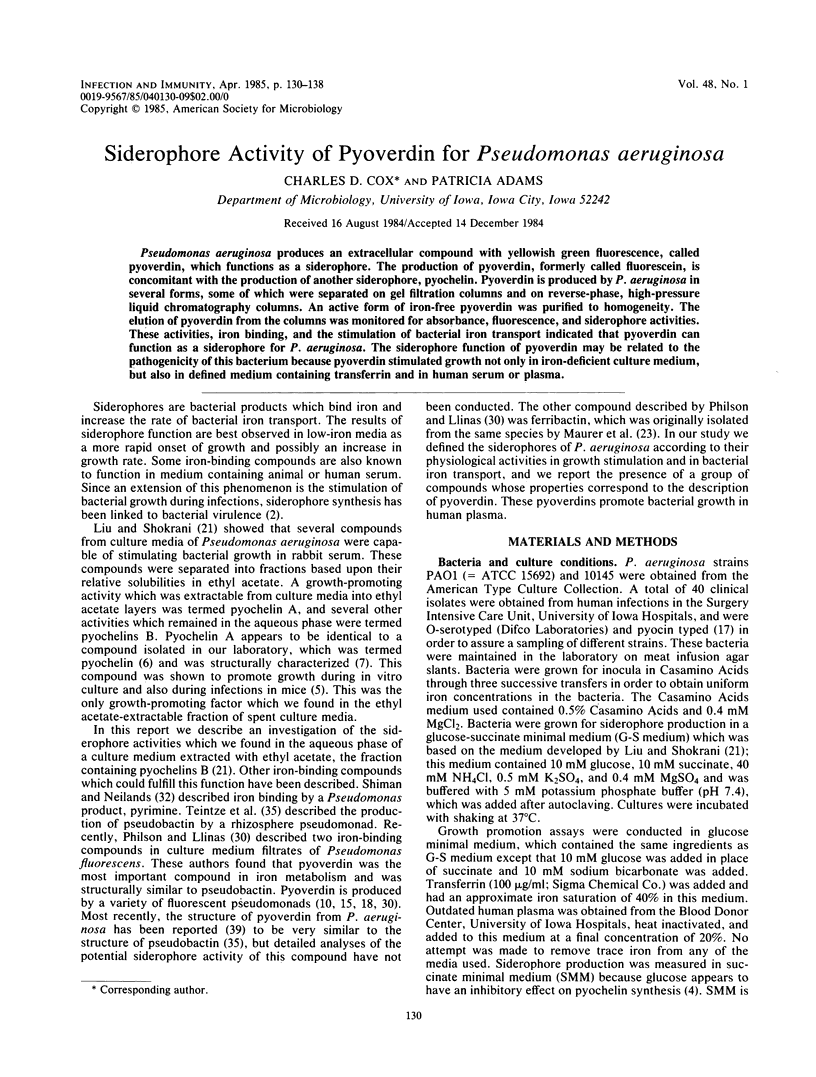
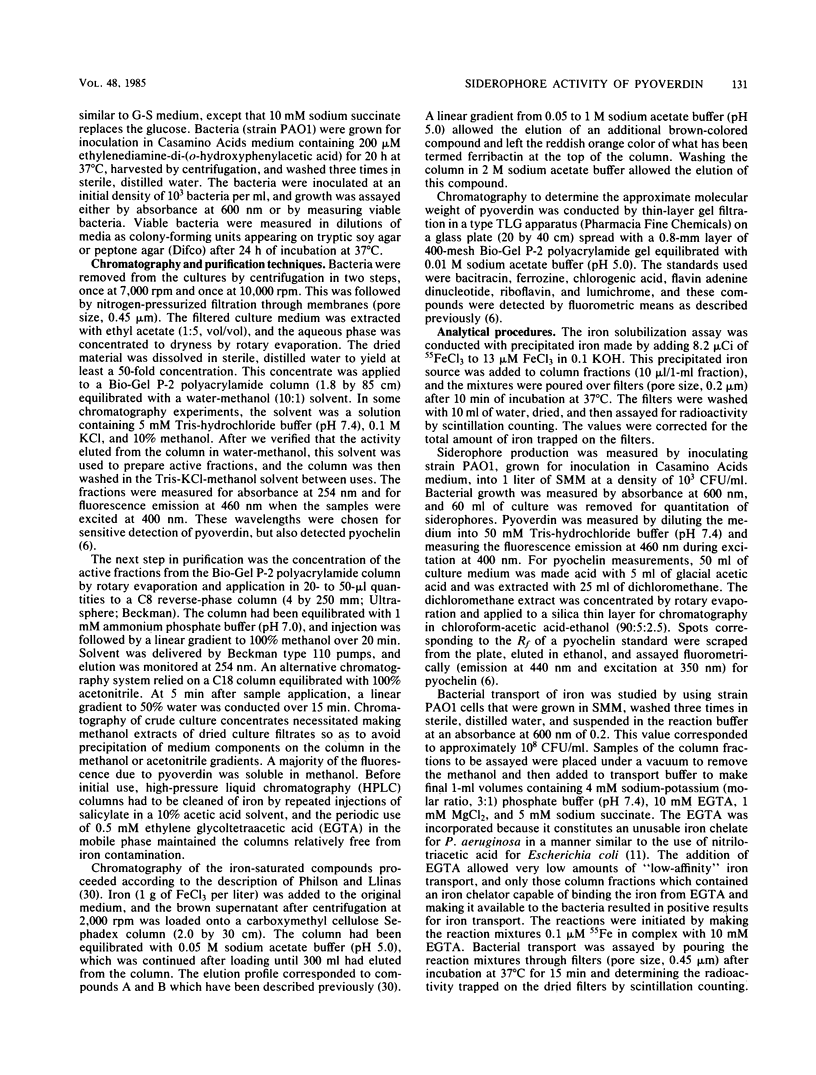
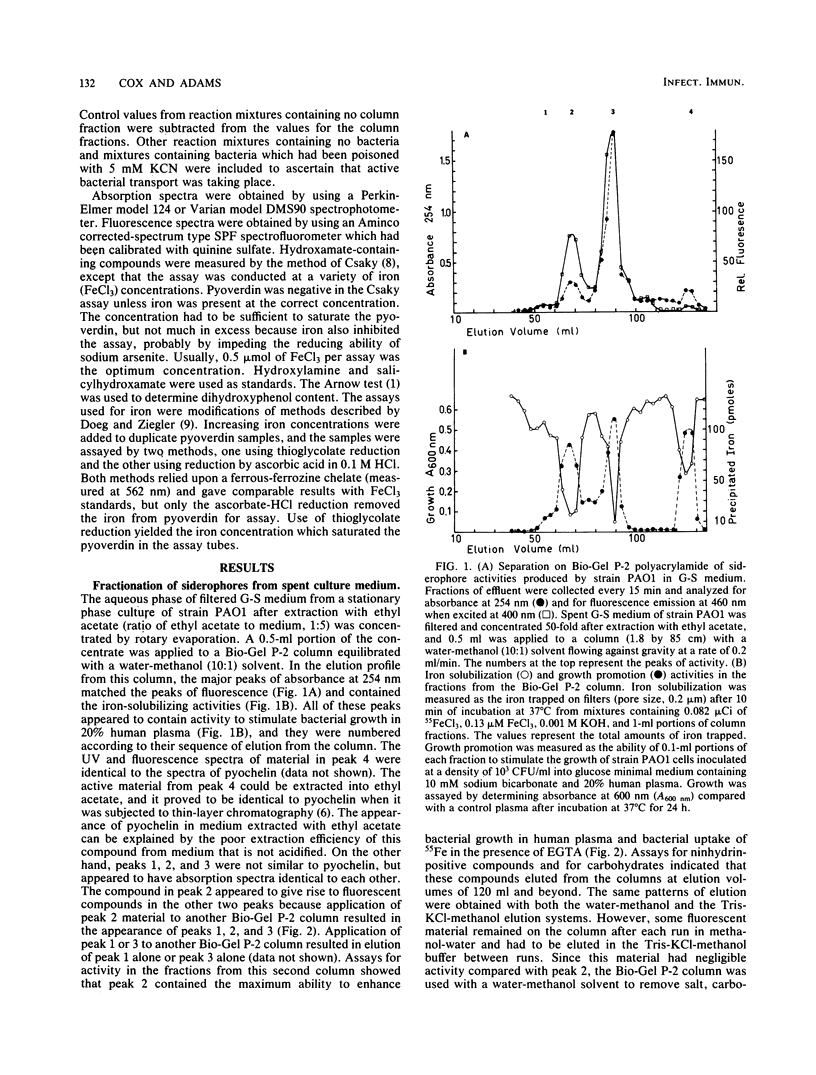
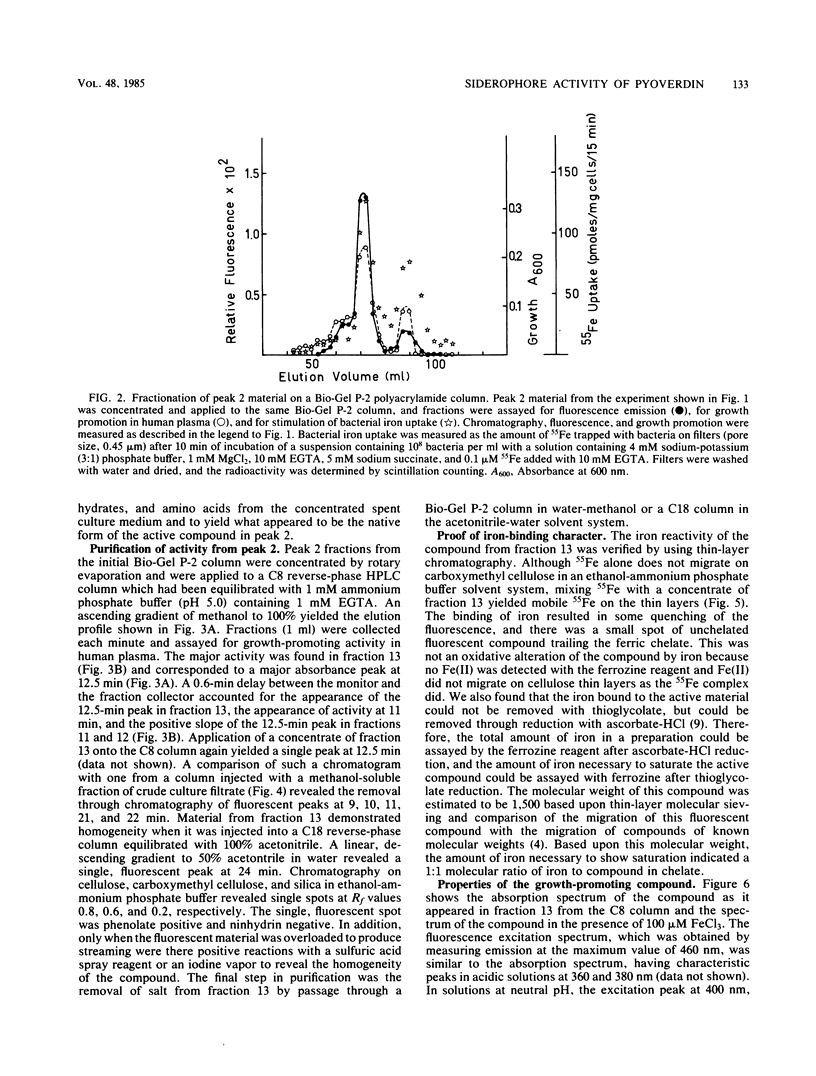
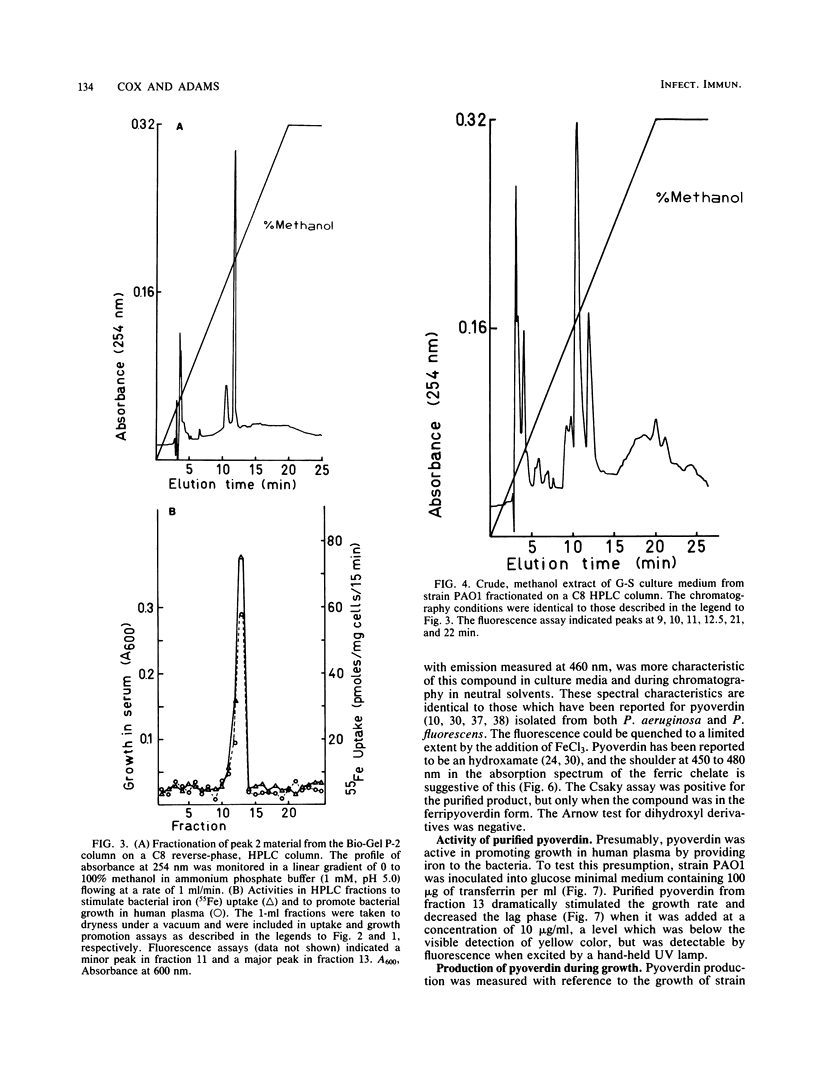
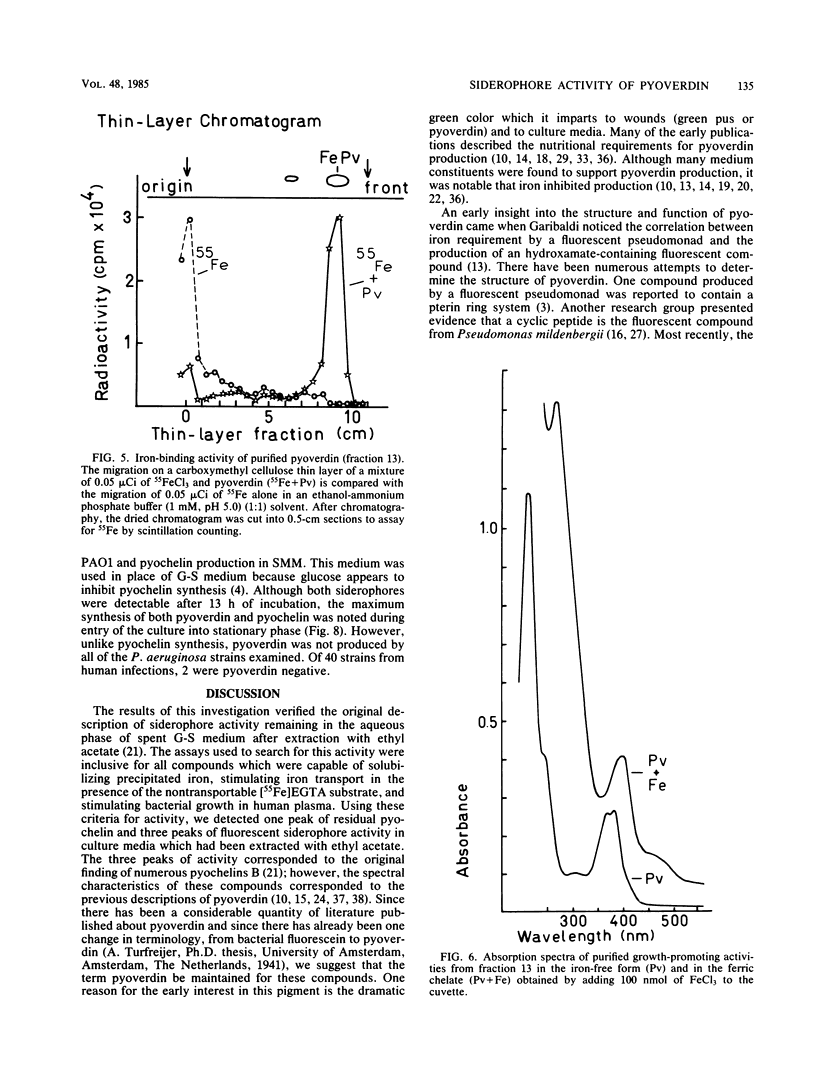
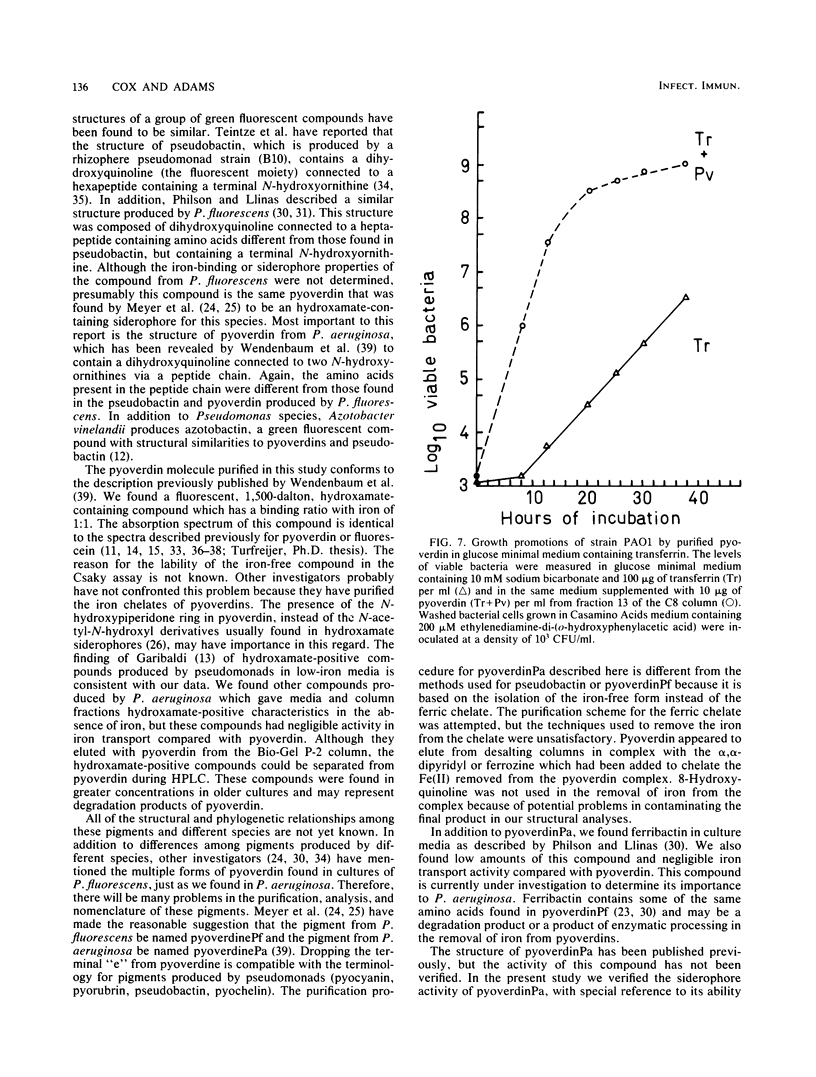
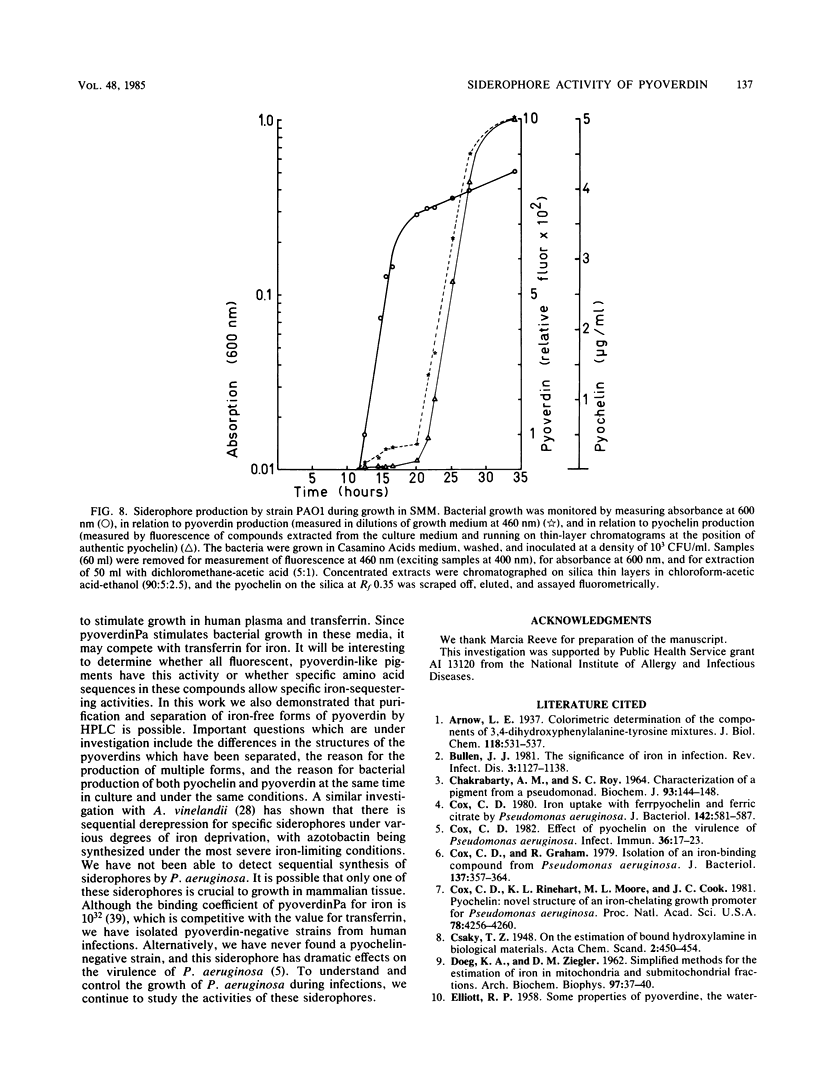
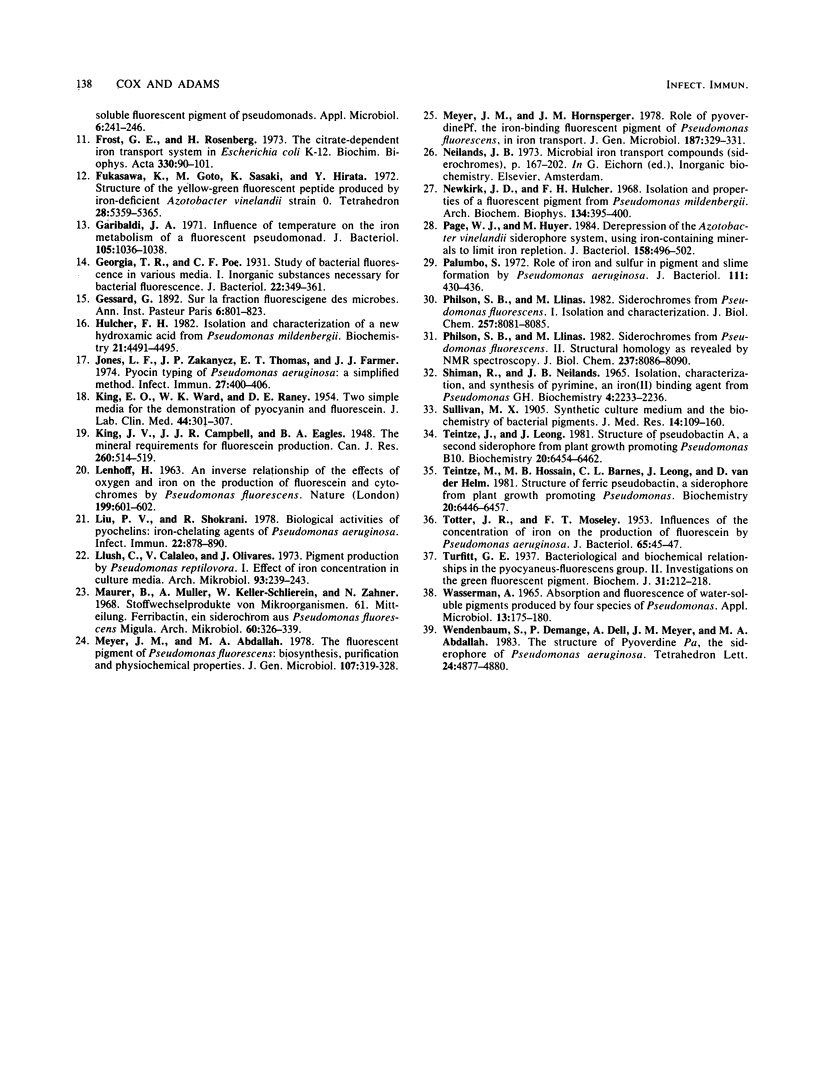
Selected References
These references are in PubMed. This may not be the complete list of references from this article.
- Bullen J. J. The significance of iron in infection. Rev Infect Dis. 1981 Nov-Dec;3(6):1127–1138. doi: 10.1093/clinids/3.6.1127. [DOI] [PubMed] [Google Scholar]
- Chakrabarty A. M., Roy S. C. Characterization of a pigment from a pseudomonad. Biochem J. 1964 Oct;93(1):144–148. doi: 10.1042/bj0930144. [DOI] [PMC free article] [PubMed] [Google Scholar]
- Cox C. D. Effect of pyochelin on the virulence of Pseudomonas aeruginosa. Infect Immun. 1982 Apr;36(1):17–23. doi: 10.1128/iai.36.1.17-23.1982. [DOI] [PMC free article] [PubMed] [Google Scholar]
- Cox C. D., Graham R. Isolation of an iron-binding compound from Pseudomonas aeruginosa. J Bacteriol. 1979 Jan;137(1):357–364. doi: 10.1128/jb.137.1.357-364.1979. [DOI] [PMC free article] [PubMed] [Google Scholar]
- Cox C. D. Iron uptake with ferripyochelin and ferric citrate by Pseudomonas aeruginosa. J Bacteriol. 1980 May;142(2):581–587. doi: 10.1128/jb.142.2.581-587.1980. [DOI] [PMC free article] [PubMed] [Google Scholar]
- Cox C. D., Rinehart K. L., Jr, Moore M. L., Cook J. C., Jr Pyochelin: novel structure of an iron-chelating growth promoter for Pseudomonas aeruginosa. Proc Natl Acad Sci U S A. 1981 Jul;78(7):4256–4260. doi: 10.1073/pnas.78.7.4256. [DOI] [PMC free article] [PubMed] [Google Scholar]
- DOEG K. A., ZIEGLER D. M. Simplified methods for the estimation of iron in mitochondria and submitochondrial fractions. Arch Biochem Biophys. 1962 Apr;97:37–40. doi: 10.1016/0003-9861(62)90041-3. [DOI] [PubMed] [Google Scholar]
- Frost G. E., Rosenberg H. The inducible citrate-dependent iron transport system in Escherichia coli K12. Biochim Biophys Acta. 1973 Nov 30;330(1):90–101. doi: 10.1016/0005-2736(73)90287-3. [DOI] [PubMed] [Google Scholar]
- Garibaldi J. A. Influence of temperature on the iron metabolism of a fluorescent pseudomonad. J Bacteriol. 1971 Mar;105(3):1036–1038. doi: 10.1128/jb.105.3.1036-1038.1971. [DOI] [PMC free article] [PubMed] [Google Scholar]
- Georgia F. R., Poe C. F. Study of Bacterial Fluorescence in Various Media: I. Inorganic Substances Necessary for Bacterial Fluorescence. J Bacteriol. 1931 Nov;22(5):349–361. doi: 10.1128/jb.22.5.349-361.1931. [DOI] [PMC free article] [PubMed] [Google Scholar]
- Hulcher F. H. Isolation and characterization of a new hydroxamic acid from Pseudomonas mildenbergii. Biochemistry. 1982 Aug 31;21(18):4491–4495. doi: 10.1021/bi00261a046. [DOI] [PubMed] [Google Scholar]
- Jones L. F., Zakanycz J. P., Thomas E. T., Farmer J. J., 3rd Pyocin typing of Pseudomonas aeruginosa: a simplified method. Appl Microbiol. 1974 Feb;27(2):400–406. doi: 10.1128/am.27.2.400-406.1974. [DOI] [PMC free article] [PubMed] [Google Scholar]
- KING E. O., WARD M. K., RANEY D. E. Two simple media for the demonstration of pyocyanin and fluorescin. J Lab Clin Med. 1954 Aug;44(2):301–307. [PubMed] [Google Scholar]
- LENHOFF H. AN INVERSE RELATIONSHIP OF THE EFFECTS OF OXYGEN AND IRON ON THE PRODUCTION OF FLUORESCEIN AND CYTOCHROME C BY PSEUDOMONAS FLUORESCENS. Nature. 1963 Aug 10;199:601–602. doi: 10.1038/199601a0. [DOI] [PubMed] [Google Scholar]
- Liu P. V., Shokrani F. Biological activities of pyochelins: iron-chelating agents of Pseudomonas aeruginosa. Infect Immun. 1978 Dec;22(3):878–890. doi: 10.1128/iai.22.3.878-890.1978. [DOI] [PMC free article] [PubMed] [Google Scholar]
- Lluch C., Callao V., Olivares J. Pigment production by Pseudomonas reptilivora. I. Effect of iron concentration in culture media. Arch Mikrobiol. 1973 Nov 2;93(3):239–243. doi: 10.1007/BF00412023. [DOI] [PubMed] [Google Scholar]
- Maurer B., Müller A., Keller-Schierlein W., Zähner H. Stoffwechselprodukte von Mikroorganismen. 61. Ferribactin, ein Siderochrom aus Pseudomonas fluorescens Migula. Arch Mikrobiol. 1968;60(4):326–339. [PubMed] [Google Scholar]
- Newkirk J. D., Hulcher F. H. Isolation and properties of a fluorescent pigent from Pseudomonas mildenbergii. Arch Biochem Biophys. 1969 Nov;134(2):395–400. doi: 10.1016/0003-9861(69)90298-7. [DOI] [PubMed] [Google Scholar]
- Page W. J., Huyer M. Derepression of the Azotobacter vinelandii siderophore system, using iron-containing minerals to limit iron repletion. J Bacteriol. 1984 May;158(2):496–502. doi: 10.1128/jb.158.2.496-502.1984. [DOI] [PMC free article] [PubMed] [Google Scholar]
- Palumbo S. A. Role of iron and sulfur in pigment and slime formation by Pseudomonas aeruginosa. J Bacteriol. 1972 Aug;111(2):430–436. doi: 10.1128/jb.111.2.430-436.1972. [DOI] [PMC free article] [PubMed] [Google Scholar]
- Philson S. B., Llinás M. Siderochromes from Pseudomonas fluorescens. I. Isolation and characterization. J Biol Chem. 1982 Jul 25;257(14):8081–8085. [PubMed] [Google Scholar]
- Philson S. B., Llinás M. Siderochromes from Pseudomonas fluorescens. II. Structural homology as revealed by NMR spectroscopy. J Biol Chem. 1982 Jul 25;257(14):8086–8090. [PubMed] [Google Scholar]
- TOTTER J. R., MOSELEY F. T. Influence of the concentration of iron on the production of fluorescin by Pseudomonas aeruginosa. J Bacteriol. 1953 Jan;65(1):45–47. doi: 10.1128/jb.65.1.45-47.1953. [DOI] [PMC free article] [PubMed] [Google Scholar]
- Teintze M., Hossain M. B., Barnes C. L., Leong J., van der Helm D. Structure of ferric pseudobactin, a siderophore from a plant growth promoting Pseudomonas. Biochemistry. 1981 Oct 27;20(22):6446–6457. doi: 10.1021/bi00525a025. [DOI] [PubMed] [Google Scholar]
- Teintze M., Leong J. Structure of pseudobactin A, a second siderophore from plant growth promoting Pseudomonas B10. Biochemistry. 1981 Oct 27;20(22):6457–6462. doi: 10.1021/bi00525a026. [DOI] [PubMed] [Google Scholar]
- Turfitt G. E. Bacteriological and biochemical relationships in the pyocyaneus-fluorescens group: Investigations on the green fluorescent pigment. Biochem J. 1937 Feb;31(2):212–218. doi: 10.1042/bj0310212. [DOI] [PMC free article] [PubMed] [Google Scholar]
- WASSERMAN A. E. ABSORPTION AND FLUORESCENCE OF WATER-SOLUBLE PIGMENTS PRODUCED BY FOUR SPECIES OF PSEUDOMONAS. Appl Microbiol. 1965 Mar;13:175–180. doi: 10.1128/am.13.2.175-180.1965. [DOI] [PMC free article] [PubMed] [Google Scholar]


